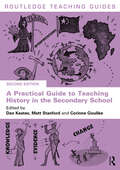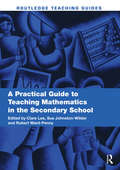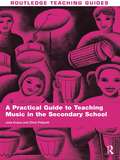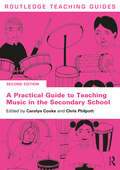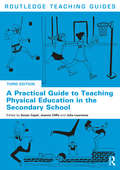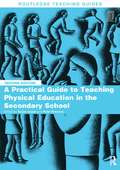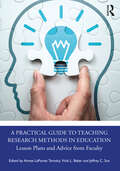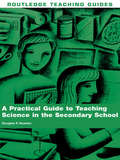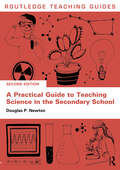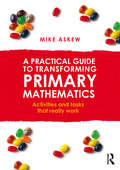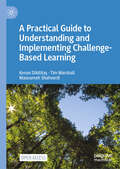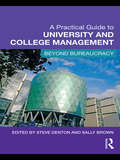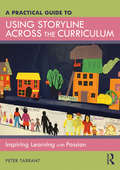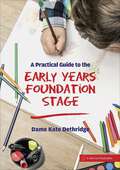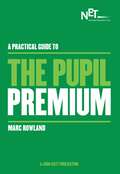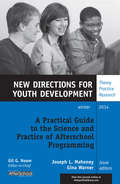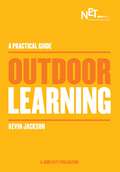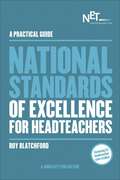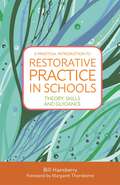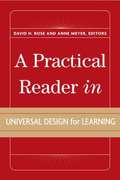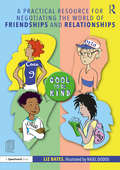- Table View
- List View
A Practical Guide to Teaching History in the Secondary School (Routledge Teaching Guides)
by Dan Keates Matt Stanford Corinne GoulléeA Practical Guide to Teaching History in the Secondary School offers comprehensive advice, inspiration and a wide range of tried and tested approaches to help you find success in the secondary history classroom. Covering all aspects of history teaching, it is designed for you to dip in and out of and to enable you to focus on specific areas of teaching, your programme or pupils’ learning.This completely revised edition has been rewritten with new chapters reflecting recent work into curriculum thought, different types of historical knowledge, designing enquiry questions and decolonising the curriculum. Emphasising the importance of pedagogy, detailed subject knowledge, a well-informed and diverse curriculum, evidence-informed practice and a focus on building long-term student understanding in the subject, the chapters cover: Curriculum design Teaching causation and consequence Teaching interpretation and significance Using evidence Delivering a more inclusive and representative history curriculum Progress and assessment Packed with ideas, resources and practical teaching activities and underpinned by the latest research, this is an essential companion for all training and early career history teachers.
A Practical Guide to Teaching Mathematics in the Secondary School
by Sue Johnston-Wilder Clare Lee Robert Ward-PennyA Practical Guide to Teaching Mathematics in the Secondary School offers straightforward advice, inspiration and support for mathematics teachers whether in training or newly qualified. Based on the best research and practice available, it offers a wide range of tried and tested approaches that succeed in secondary classrooms. Each chapter contains a wealth of tasks and ideas that allow teachers to reflect on the approaches and make plans for using them in their own classrooms, and offers ideas for lesson plans, learning activities and suggested further reading and development. Illustrated throughout with case studies and practical insights from classroom observations and experience, this book covers key aspects of mathematics teaching, including: managing the class and learning environment; teaching the topics of mathematics; encouraging mathematical thinking; choosing and using resources; using multi-media technology; assessing work in mathematics. A Practical Guide to Teaching Mathematics in the Secondary School is an essential companion to the core textbook Learning to Teach Mathematics in the Secondary School. Written by expert professionals, it supports you in your development of imaginative and effective lessons on a variety of curriculum topics in different teaching situations.
A Practical Guide to Teaching Music in the Secondary School
by Julie Evans Chris PhilpottA Practical Guide to Teaching Music in the Secondary School provides valuable support, guidance and creative ideas for student teachers, mentors and practising teachers who want to develop their music teaching. Written to accompany the successful textbook Learning to Teach Music in the Secondary School, it will help you understand important current developments and explore new possibilities for teaching and learning. Focusing on teaching music musically, the book explores musical learning through placing pupils at the centre of a musical experience. Considering the revised KS3 curriculum and the 14--19 agenda in music, it also seeks to broaden the perspectives of music teachers through engaging with collaborative practice, transitions and cross-curricular work. Key issues explored include: personalising musical learning teaching creatively and promoting creativity approaches to using ICT in the classroom musical collaboration with other adults assessment for learning in music making connections with other subjects. Using practical examples and tasks, this book will help you critically examine the way in which children learn music. It is an invaluable resource for those involved in teaching music who are seeking to develop their practical and theoretical understanding.
A Practical Guide to Teaching Music in the Secondary School (Routledge Teaching Guides)
by Carolyn CookeThis updated second edition of A Practical Guide to Teaching Music in the Secondary School provides valuable support, guidance and creative new ideas for students and practising teachers who want to develop their music teaching practice. Written to accompany the successful textbook Learning to Teach Music in the Secondary School, it explores a range of current issues, developments and opportunities within music education. The book supports the reader in undertaking practical enquiries across the breadth of the subject to support their critical reflection and the development of their own context-relevant strategies and understandings. Key themes explored include the pedagogy of: • singing; • composing; • improvising; • performing; • responding; • musical literacy; • music and cross-curricular learning. Using practical examples and reflective activities, this book will help you critically examine ways in which you can place pupils at the centre of learning music. It is an invaluable resource for those involved in teaching music who are seeking to develop their practical and theoretical understanding, whether at a trainee or practising music teacher level.
A Practical Guide to Teaching Physical Education in the Secondary School (Routledge Teaching Guides)
by Julia Lawrence Susan Capel Joanne CliffeA Practical Guide to Teaching Physical Education in the Secondary School is written for all student teachers on university and school-based initial teacher education programmes. It offers a wealth of tried and tested strategies together with practical activities and materials to support your teaching to enhance pupils’ learning. It is designed for you to dip in and out of, and enable you to focus on specific areas of teaching, your programme or pupils' learning. This third edition is fully updated with the most recent developments in teaching physical education and features five brand new chapters. Key topics covered include: Planning schemes of work, units of work and lessons Safe practice, risk assessment and risk management Promoting positive behaviour Applying theories of learning to your practice Overcoming barriers and maximising the achievement of all pupils Assessing learning Physical literacy NEW Health related learning NEW Using digital technologies NEW Reflective practice and action research Managing your workload, resilience, health and well-being NEW Working with your mentor NEW Photocopiable resources offer assistance in lesson observation, planning, preparation, teaching and evaluation. An annotated 'Further resources' section at the end of each chapter provides information about some useful additional resources to support you in your development as a teacher. Illustrated throughout with examples of existing good practice, this highly practical resource offers valuable support and guidance to all student teachers as well as those in the early years of their teaching career. Although A Practical Guide to Teaching Physical Education in the Secondary School, 3rd Edition can be used successfully on its own, it is also a companion to Learning to Teach Physical Education in the Secondary School, 5th Edition and can be used to reinforce the basic teaching skills covered in that core textbook.
A Practical Guide to Teaching Physical Education in the Secondary School (Routledge Teaching Guides)
by Susan Capel Peter BreckonA Practical Guide to Teaching Physical Education in the Secondary School is written for all student teachers on university and school-based initial teacher education courses. It offers a wealth of tried and tested strategies together with practical activities and materials to support both your teaching and your pupils’ learning. It is designed for you to dip in and out of, to enable you to focus on specific areas of teaching or foci on your course. This second edition is fully updated with the most recent research and developments in the field and includes brand new chapters. Key topics covered include: Understanding your own views about your subjectNEW Lesson planning and schemes of work Physical Education and Key Skills Using ICT Cross-curricular teaching and learningNEW Safe practice, risk assessment and risk management Applying theories of learning to your practice Helping pupils meet intended learning outcomesNEW Promoting positive behaviourNEW Overcoming barriers and maximising the achievement of all pupilsNEW Assessing learning Working with others Reflective practice and action research. Photocopiable resources offer easy assistance in lesson observation, planning, preparation, delivery and evaluation. An annotated further reading section at the end of each chapter provides advice about selection of the best resources on the web and elsewhere. Illustrated throughout with examples of existing good practice, this highly practical resource offers valuable support and inspiration to all student teachers as well as those in the early years of their teaching career. A Practical Guide to Teaching Physical Education in the Secondary School, 2nd edition is a companion to Learning to Teach Physical Education in the Secondary School, 3rd edition and can be used to reinforce the basic teaching skills covered in that core textbook. The book can also be used equally successfully on its own.
A Practical Guide to Teaching Research Methods in Education: Lesson Plans and Advice from Faculty
by Vicki L. Baker Jeffrey C. Sun Aimee LaPointe TeroskyA Practical Guide to Teaching Research Methods in Education brings together more than 60 faculty experts. The contributors share detailed lesson plans about selected research concepts or skills in education and related disciplines, as well as discussions of the intellectual preparation needed to effectively teach the lesson. Grounded in the wisdom of practice from exemplary and award-winning faculty from diverse institution types, career stages, and demographic backgrounds, this book draws on both the practical and cognitive elements of teaching educational (and related) research to students in higher education today. The book is divided into eight sections, covering the following key elements within education (and related) research: problems and research questions, literature reviews and theoretical frameworks, research design, quantitative methods, qualitative methods, mixed methods, findings and discussions, and special topics, such as student identity development, community and policy engaged research, and research dissemination. Within each section, individual chapters specifically focus on skills and perspectives needed to navigate the complexities of educational research. The concluding chapter reflects on how teachers of research also need to be learners of research, as faculty continuously strive for mastery, identity, and creativity in how they guide our next generation of knowledge producers through the research process. Undergraduate and graduate professors of education (and related) research courses, dissertation chairs/committee members, faculty development staff members, and graduate students would all benefit from the lessons and expert commentary contained in this book.
A Practical Guide to Teaching Science in the Secondary School (Routledge Teaching Guides)
by Douglas P. NewtonThis practical and accessible workbook is designed to support student teachers as they develop their basic teaching skills and increase their broader knowledge and understanding for teaching science. Newly qualified and beginning teachers should also find it useful. It contains all the advice, guidance and resources new and student science teachers need to reflect on and develop their teaching practice, helping them to plan lessons across the subject in a variety of teaching situations. Helpful features include: case studies examples of pupils’ work examples of existing good practice a range of tried-and-tested teaching strategies photocopiable resources and training materials activities in each chapter to help student history teachers analyse their learning and performance web links for further reading on evidence-based practice.
A Practical Guide to Teaching Science in the Secondary School (Routledge Teaching Guides)
by Douglas P. NewtonA Practical Guide to Teaching Science in the Secondary School is designed to support student teachers as they develop their teaching skills and increase their broader knowledge and understanding for teaching science. It offers straightforward advice and inspiration on key topics such as planning, assessment, practical work, the science classroom, and on to the broader aspects of teaching science. This thoroughly updated second edition reflects on new expectations, requirements, and practices in science teaching, with chapters exploring key and contemporary topics such as: The nature of science and scientific argument The various kinds of thinking emphasised in science and how to exercise them How to engage students in learning Assessment for and of learning Diverse needs and how to meet them The use of technology to support teaching and learning Learning at a distance. Designed to be used independently or alongside the popular textbook Learning to Teach Science in the Secondary School, this book is packed with revised and updated case studies, examples of pupils' work, and resources and activities in every chapter. It provides everything trainee and early career teachers need to reflect on and develop their teaching practice, helping them to plan lessons across the subject in a variety of teaching situations.
A Practical Guide to Transforming Primary Mathematics: Activities and tasks that really work
by Mike AskewA Practical Guide to Transforming Primary Mathematics offers inspiration and ideas for all training and practising teachers committed to making mathematics enjoyable, inclusive, engaging and successful. The companion to Mike Askew’s bestselling book, Transforming Primary Mathematics, this practical guide focuses on showing you how to unlock the powerful potential of a small set of consistent principles and practices, known as the teaching tripod, to develop a coherent approach to teaching mathematics. Organised around the major strands of the curriculum - number, calculations, shape and space, measures, and data handling – it offers an accessible introduction to the teaching tripod, a careful choice of tasks, supported by a range of tools that extend our natural abilities and held together by careful attention to classroom talk. A range of classroom tasks, each including key learning outcomes, clear links to the framework, links to relevant research, and suggestions for making the tasks easier or harder, are offered for every topic, helping you plan units of work for meaningful learning. A Practical Guide to Transforming Primary Mathematics offers all teachers a vision, rationale and ideas for how teaching can support better learning of mathematics but also encourage learners to see themselves as being capable of learning mathematics, and wanting to learn it.
A Practical Guide to Understanding and Implementing Challenge-Based Learning
by Tim Marshall Kenan Dikilitaş Masoumeh ShahverdiThis open access book maps the role of challenge-based learning (CBL) in the transformation of higher education pedagogy, towards being sector-informed as well as student-driven. CBL democratises the process of learning by repositioning students as drivers, who are empowered to make decisions on course content, assess needs in the real world and develop opinions. Teachers monitor student learning and engagement and mentor students to express their needs. Chapters showcase existing CBL practices in different settings, and include case studies which detail the practical application of CBL in multiple contexts. The authors develop an emerging theory of practical learning based on the insights of the curriculum designers, practitioners and students. The book will be of interest to researchers, teacher educators/trainers and research supervisors in higher education.
A Practical Guide to University and College Management: Beyond Bureaucracy
by Sally Brown Steve DentonWritten for Higher Education managers and administrators, A Practical Guide to University and College Management is a highly accessible text that offers practical guidance on how to manage the day-to-day life of universities. The authors take a proactive approach and offer a range of good practice examples and solutions, designed to resolve the dilemmas that arise in today’s rapidly changing higher education environment. Drawing on a wealth of management experience, this edited collection pulls together advice and practical guidance from expert managers working in the field of Higher Education. Each chapter is underpinned by theoretical perspectives to support invaluable pragmatic hints, mini-case studies, practical examples, and sample guidelines. The book covers four main areas: Selecting and inducting students: This section outlines the essential process for targeting, attracting, recruiting and inducting students Managing throughout the university year: Advice on the student experience, from the admissions process right up to graduation Assuring the quality of the student learning experience: How to manage course administration, student learning through assessment, student complaints and issues of quality assurance Maximising staff and student engagement: This section looks at how to maximise commitment and involvement by both staff and students, and includes approaches and examples of engagement implementation at other universities A Practical Guide to College and University Management will be of interest to Higher Education managers, administrators, and anyone looking for a pragmatic "how to" navigational guide that informs the working life of a university, from attracting students through to graduation. It offers managers and administrators essential training and support required to promote highly successful and efficient Higher Education Institutions, and is essential reading for anyone who works in university administration or aspires to do so. Sally Brown is Pro-Vice-Chancellor for Assessment, Learning and Teaching at Leeds Metropolitan University. She has published widely on innovations in teaching, learning and particularly assessment. Steve Denton is Pro-Vice-Chancellor and Registrar and Secretary at Leeds Metropolitan University bringing together University-wide student administrative and support services, including governance and legal matters, the academic registry, planning, student services, communication and marketing and widening access and participation.
A Practical Guide to Using Storyline Across the Curriculum: Inspiring Learning with Passion
by Peter TarrantA Practical Guide to Using Storyline Across the Curriculum provides a comprehensive introduction to the Storyline approach to teaching and learning – an approach that embraces and encourages children’s passion for learning. Putting children at the centre of learning, the book explores how educators and teachers can harness pupils’ innate appetite for stories to make interdisciplinary teaching and learning enjoyable and successful. Demonstrating how teachers can easily use the Storyline approach within the curriculum, this book offers a step-by-step introduction to learning developed through the use of narrative. Key topics explained include: planning individual lessons and sequences of lessons; guidance on planning and progress; assessment and evaluation of learning; links with visible learning and growth mindset approaches. Filled with detailed examples of storylines that have been tried and tested in the classroom, A Practical Guide to Using Storyline Across the Curriculum offers new and experienced teachers an accessible guide to the Storyline approach, with ready-to-use ideas to enable, inspire and support learners.
A Practical Guide to the Early Years Foundation Stage
by Kate Dethridge'A Practical Guide to Early Years Education' has been written in order to support colleagues in gaining an understanding of what excellent provision looks like and offers tools and resources to help you manage, improve and sustain high quality provision in your setting. Pick up a book about Early Years education and too often it is heavily weighted to research and theory. These are important of course, but for many of us who are busy and time poor, we want to be able to open a book and find it full of good ideas and easily accessible resources, easy to read and written by someone who does the job day in and day out. Whether you are a child minder, work in a nursery or in a school, this book will offer you sensible, practical advice about what you can do to improve the experience for the children in your care, meet their individual needs and sustain improved learning outcomes.Written in a clear and easily accessible way, each chapter focuses on a key area of provision and offers a wealth of practical ideas and resources to help you: *Understand what excellent provision looks like and should include * Audit your own provision and identify strengths and areas to improve * Develop resources and guidance for staff to ensure that your setting offers all the necessary support and skills to ensure the children in your care are stimulated, develop excellent attitudes to learning and make progress.
A Practical Guide to the Early Years Foundation Stage
by Kate Dethridge'A Practical Guide to Early Years Education' has been written in order to support colleagues in gaining an understanding of what excellent provision looks like and offers tools and resources to help you manage, improve and sustain high quality provision in your setting. Pick up a book about Early Years education and too often it is heavily weighted to research and theory. These are important of course, but for many of us who are busy and time poor, we want to be able to open a book and find it full of good ideas and easily accessible resources, easy to read and written by someone who does the job day in and day out. Whether you are a child minder, work in a nursery or in a school, this book will offer you sensible, practical advice about what you can do to improve the experience for the children in your care, meet their individual needs and sustain improved learning outcomes.Written in a clear and easily accessible way, each chapter focuses on a key area of provision and offers a wealth of practical ideas and resources to help you: *Understand what excellent provision looks like and should include * Audit your own provision and identify strengths and areas to improve * Develop resources and guidance for staff to ensure that your setting offers all the necessary support and skills to ensure the children in your care are stimulated, develop excellent attitudes to learning and make progress.
A Practical Guide to the Pupil Premium
by Marc RowlandPublished in partnership with the National Education Trust, this book provides essential information and advice to help schools make best use of the Pupil Premium grant and improve outcomes for disadvantaged learners. The author visited more than 100 schools over two years and here he shares examples of innovation and excellence in their use of the additional funding. The book includes official Government directives on the Pupil Premium, which was introduced in 2011 to narrow the attainment gap between disadvantaged learners and their more affluent peers.
A Practical Guide to the Pupil Premium
by Marc RowlandPublished in partnership with the National Education Trust, this book provides essential information and advice to help schools make best use of the Pupil Premium grant and improve outcomes for disadvantaged learners. The author visited more than 100 schools over two years and here he shares examples of innovation and excellence in their use of the additional funding. The book includes official Government directives on the Pupil Premium, which was introduced in 2011 to narrow the attainment gap between disadvantaged learners and their more affluent peers.
A Practical Guide to the Science and Practice of Afterschool Programming: New Directions for Youth Development, Number 144 (J-B MHS Single Issue Mental Health Services)
by Joseph L. Mahoney Gina WarnerClosing the gap between scientific research on afterschool programming and the practices occurring in these settings is the goal of this volume. Both sources of knowledge are critical to developing the afterschool workforce’s ability to provide high-quality programming. On the one hand, this means afterschool staff should not work with young people until they have been adequately prepared—which includes training in evidence-based practices—and properly supervised. On the other hand, it requires that scientists understand and study those aspects of afterschool programming most relevant to the needs of practitioners. This volume includes perspectives from the afterschool workforce, scientists who discuss the current research, and the practitioners who know how afterschool programs operate in practice. This is the 144th volume of New Directions for Youth Development, the Jossey-Bass quarterly report series dedicated to bringing together everyone concerned with helping young people, including scholars, practitioners, and people from different disciplines and professions.
A Practical Guide: A Practical Guide
by Kevin JacksonAn informative, practical and authoritative guide that makes the argument for undertaking outdoor and adventurous learning - and offers advice for how to organise trips to enable students and teachers to get the most from them. Inspiring enthusiasm for real learning and growing, it provides opportunities for children, young people and their teachers to seek memorable experiences and develop life-long interests.
A Practical Guide: A Practical Guide
by Kevin JacksonAn informative, practical and authoritative guide that makes the argument for undertaking outdoor and adventurous learning - and offers advice for how to organise trips to enable students and teachers to get the most from them. Inspiring enthusiasm for real learning and growing, it provides opportunities for children, young people and their teachers to seek memorable experiences and develop life-long interests.
A Practical Guide: The National Standards of Excellence for Headteachers
by Roy BlatchfordThis Practical Guide seeks to illuminate the National Standards of Excellence for Headteachers, presenting a range of perspectives to bring the text alive for current and future school leaders and for those with the vital responsibilities of proper governance. Part Two of the book comprises the official Standards published by the DfE, by way of handy reference.
A Practical Guide: The National Standards of Excellence for Headteachers
by Roy BlatchfordThis Practical Guide seeks to illuminate the National Standards of Excellence for Headteachers, presenting a range of perspectives to bring the text alive for current and future school leaders and for those with the vital responsibilities of proper governance. Part Two of the book comprises the official Standards published by the DfE, by way of handy reference.
A Practical Introduction to Restorative Practice in Schools: Theory, Skills and Guidance
by Margaret Thorsborne Bill HansberryProven to reduce bad behaviour and exclusions, and encourage happier, safer school environments, restorative justice is an effective approach to conflict resolution. Suitable for education settings from preschool to college, this guide explains what restorative justice is, how it can be used in schools, what it looks like in the classroom and how it can be implemented. Featuring case studies that illuminate the underlying restorative principles and practices, this book covers a wide range of topics from the basics of restorative justice, through to school-wide processes for embedding the approach in policy and practice. Drawing on the expertise of educators and consultants, this is a must-have resource for any school or centre that is serious about reducing bad behaviour and developing safer learning communities.
A Practical Reader in Universal Design for Learning
by Anne Meyer David H. RoseUniversal Design for Learning (UDL) stands at the forefront of contemporary efforts to create universal access to educational curricula for all students, including those with disabilities. The universal in UDL does not mean there is a single optimal solution for everyone.
A Practical Resource for Negotiating the World of Friendships and Relationships
by Liz BatesThis is a practical resource for use by teachers, support staff and therapists that contains session ideas for use with children to promote kindness, friendship and self-compassion. It includes detailed lesson plans with extensive guidance and photocopiable activity sheets to support individuals, groups or classes of children aged 7 and upwards. This guidebook can be used to: Help children understand the value of kindness, both to themselves and to others Nurture the moral development of children Support children who may be struggling with self-worth and self-kindness This guidebook is available to purchase as part of a two-component set, Negotiating the World of Friendships and Relationships: A ‘Cool to be Kind’ Storybook and Practical Resource. It can be used by teachers, support staff and therapists to teach and promote kindness.
